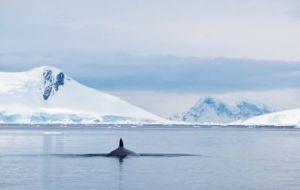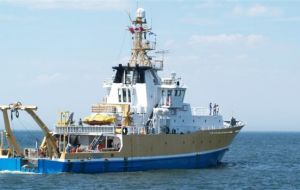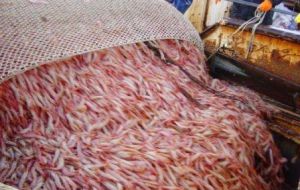MercoPress. South Atlantic News Agency
Argentina's “Blue Pampa” project to research and develop South Atlantic resources
 South Georgia waters is one of the targets as well as Antarctic waters
South Georgia waters is one of the targets as well as Antarctic waters  Canada's Coriolis II, has already been working in two of the Blue Pampa project areas
Canada's Coriolis II, has already been working in two of the Blue Pampa project areas  The San Jorge Gulf area is describes as the most profitable fisheries because of shrimp
The San Jorge Gulf area is describes as the most profitable fisheries because of shrimp The recently launched “Blue Pampa” project is a ten-year 'strategic initiative' with the purpose of researching South Atlantic resources in five different areas to ensure conservation and management, plus reinforce Argentine sovereignty with inter-disciplinary campaigns and inter-ministerial support, according to Argentina's Science, Technology and Productive Innovation ministry.
“The initiative will promote technologic innovations applicable to the sustainable exploitation of natural resources and the development of industries linked to the sea, strengthening Argentina's maritime conscious, supporting with data and a scientific presence our sovereignty in the South Atlantic”, reads the official instruction.
The five geographic areas established as priorities are the so called “Blue Hole” on the continental slope; the “Burdwood-Namuncurá” bank; the San Jorge Gulf; sub-Antarctic zones including the maritime spaces of South Georgia and South Sandwich islands and the River Plate estuary.
The “blue hole” in the ocean slope is described by the Argentine ministry as the “largest and most productive of maritime fronts” in the area, where Argentine jurisdictional waters meet with the ocean. Blue hole research should supply data for the “integral management of fisheries which operate over highly migrating, straddling species, and with a distribution that overlaps international waters”.
The Burwood-Namuncurá is a “submarine plateau approximately 150 kilometers east of the Estates island, with a minimum depth of 50 meters and a feeding ground for predators such as albatross, petrels, penguins, sea lions and sea elephants”. Adjacent are areas of reproduction for “Southern bluewhiting and Patagonian toothfish and Patagonian sardine spawning”.
In 2008 the Argentine Federal Fisheries Council established “a total permanent ban on fishing” in the bank area and under Law 26.785 was declared a “marine protected area”
The third priority area, the San Jorge Gulf has the ”most profitable fisheries of the Argentine Sea (South Atlantic)“ mainly because of shrimp. Sustaining the ecosystem means understanding ”the management criteria based on possible anthropogenic impacts“
The fourth area is defined by the maritime spaces of South Georgia and South Sandwich islands and are contemplated in the framework of CCMLR, convention for the conservation of marine living resources. The 'Blue Pampa' in this area will research the impact on the islands biology production from the Circumpolar Antarctic current.
Finally the River Plate estuary, ”one of the most important of the Southern Hemisphere only second to the Amazon“. In this area the ”underground discharge of continental waters supplies a huge volume of water with its own chemical and physic characteristics“, according to the project's goals.
Argentina's presidential office website describes ”Blue Pampa“ as an ambitious, strategic project which must become 'state policy' to be continued by all governments since in ”the Argentine Sea (South Atlantic) are our food resources”.
The continental shelf and adjacent ocean waters are an important source of food, regulate the continental climate and capture greenhouse gases, said the Ministry.
Vessels involved in the last twelve months in the project include Canada's RV Coriolis II (Blue hole and San Jorge Gulf); SB-15 Tango (Namuncurá-Burdwood bank); Dr. Holmberg (South Georgia) and Puerto Deseado, (Antarctica).
The so called Technological Scientific cabinet, coordinates the Blue Pampa project with participation of the Foreign Affairs; Agriculture, Livestock and Fisheries; Tourism; Security and Defense ministries and the Environment and Sustainable development Secretariat.
Other institutions involved are CONICET, (scientific and technical research council); Antarctic Department, DNA; Space Activities Commission, (CONAE); Fisheries Development and Research Institute, (INIDEP); Naval Hydrographic Service (SHN); Coast Guard and Center-Austral scientific research center (CADIC.CONICET).
Likewise the Patagonia National Center; the Argentine Oceanographic institute; the Marine and Coastal research institute; Sea and Atmosphere research center; the Almirante Storni Marine biology and Fisheries Institute. The project also enumerates the following universities: Plus Comahue; Patagonia San Juan Bosco; Tierra del Fuego Antarctica and South Atlantic Islands; Austral Patagonia; Mar del Plata; La Plata; Southern and Buenos Aires.




Top Comments
Disclaimer & comment rules-

-

-

Read all commentsI dont get it, dont they know the migratory and biological cycles of these fisheries of the South Atlantic by now??
Apr 30th, 2014 - 04:05 am 0Ufff I do know one thing for sure this will be more money spent to these governmental institutions like CONICET and CONAE that have rockets blow up in pieces at a couple of meters from the ground in take off after years of pouring in investment in these “institutions”.
More money for football for everyone as they have added in 10 clubs into the first league by decree, which also means the cost for transmition of matches will go up to over a Billion pesos per year and the quality of football will go poorer and poorer.
When is this populist nightmare ever going to end '?
'Plus reinforce Argentine sovereignty' What Argentine sovereignty? Lol. Empty rhetoric and bluster.
Apr 30th, 2014 - 04:33 am 0They cant make a go with the land they fucking sit on :-)
Apr 30th, 2014 - 06:06 am 0Commenting for this story is now closed.
If you have a Facebook account, become a fan and comment on our Facebook Page!